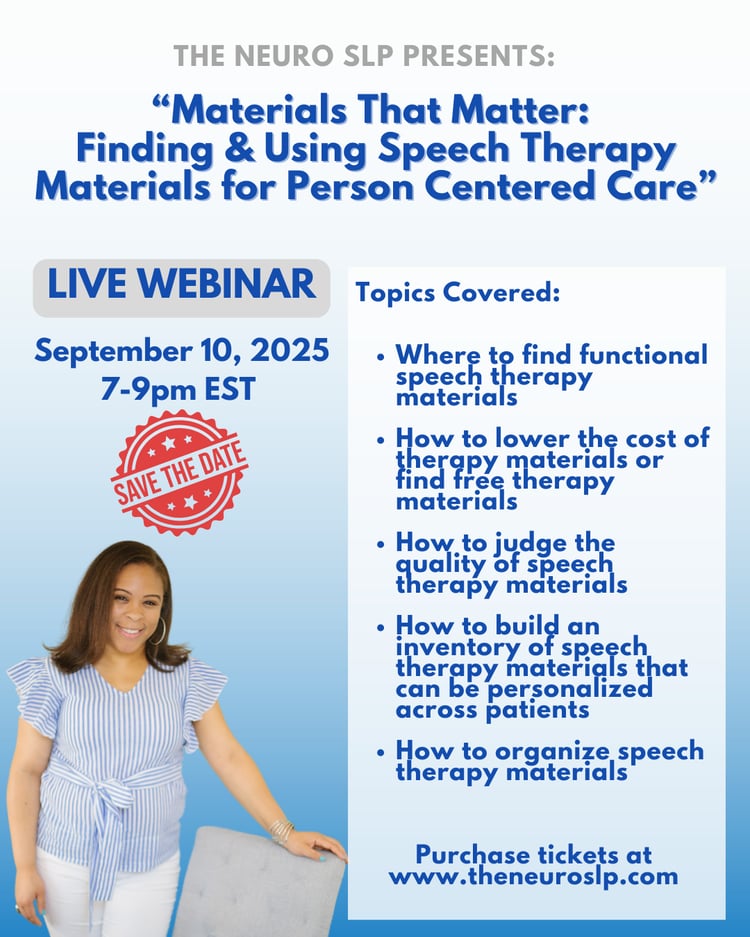Once I learned that workbooks don’t work (see references below) and committed to delivering FUNctional and person centered care to my patients, I knew that I needed therapy materials that were a lot different than what I had.
I had flashcards.
I had workbooks.
I even had board games in the office left by the previous SLP.
So, I went on the hunt for better materials that I could use in FUNctional therapy activities with patients…… and at first, I was spending a lot of money. My pockets made me pause and re-think things.
I wasn’t getting extra money from my workplace to buy “functional” materials, but I also needed to stop spending my own hard-earned money on functional therapy materials.
This dilemma forced me to start thinking SIMPLE when it came to therapy materials. Seeing therapy materials through a new lens has helped me save so much time and money and I want it to help you do the same.
Since then, I have found materials to use in therapy sessions in my home, in my community, in the thrift store, and even the dollar store. I have created a complete inventory of speech therapy materials that MATTER and I use them often. Magazines, greeting cards, grocery store ads, shopping mall maps, car manuals, time sheets, note templates, and so much more! When I’m not using materials in my inventory, I find what I need online or ask the patient to bring in materials so we can work on stuff together.
A patient is returning to work and needs to practice administration tasks? I have materials for that.
A patient needs to get better taking notes in medical appointments or church services? I have materials for that.
A patient needs to figure out the best external memory aids for them on a daily basis? I have materials for that.
A patient needs to improve attention to household tasks? I have materials for that.
I have materials for it all. And as I mentioned, what I don’t have materials for; I find resources online that serve as our “therapy materials” to engage in a FUNctional task.
The result is 1.) increased patient motivation and engagement, 2.) increased patient satisfaction, and 3.) overall patient outcomes. Isn’t that what we want?
No more wasting time. No more using outdated clinical practices. Use real-life materials and situations to capitalize on principles of neuroplasticity such as SALIENCE and SPECIFICITY.
If you’re feeling stuck with finding and using meaningful therapy materials (that are free or affordable), join my live webinar “Materials That Matter: Finding & Using Speech Therapy Materials for Person Centered Care”.
During this webinar, i will walk you through step-by-step how to build an inventory of speech therapy materials you can use over and over, yet still personalize for each patient.
Click HERE for more webinar details.

Relevant Research:
Baylor, C., & Darling-White, M. (2020). Achieving participation-focused intervention through shared decision making: Proposal of an age- and disorder-generic framework. American Journal of Speech-Language Pathology, 29(3), 1335–1360
Cornis-Pop, M., Mashima, P. A., Roth, C. R., MacLennan, D. L., Picon, L. M., Hammond, C. S., Goo-Yoshino, S., Isaki, E., Singson, M., & Frank, E. M. (2012). Cognitive-communication rehabilitation for combat-related mild traumatic brain injury. Journal of Rehabilitation Research and Development, 49(7), xi–xxxii.
Guideline Development Panel, Brown, J., Kaelin, D., Mattingly, E., Mello, C., Miller, E. S., Mitchell, G., Picon, L. M., Waldron-Perine, B., Wolf, T. J., Frymark, T., & Bowen, R. (2022). American Speech-Language-Hearing Association Clinical Practice Guideline: Cognitive Rehabilitation for the Management of Cognitive Dysfunction Associated With Acquired Brain Injury. American journal of speech-language pathology, 31(6), 2455–2526.
Kleim, J. A., & Jones, T. A. (2008). Principles of experience-dependent neural plasticity: implications for rehabilitation after brain damage. Journal of speech, language, and hearing research : JSLHR, 51(1), S225–S239. https://doi.org/10.1044/1092-4388(2008/018)
Mattingly, E. O. (2018). Functional evaluation and treatment in acquired brain injury: Acute rehabilitation. Perspectives of the ASHA Special Interest Groups, 3(2), 13–20.


Comments ()